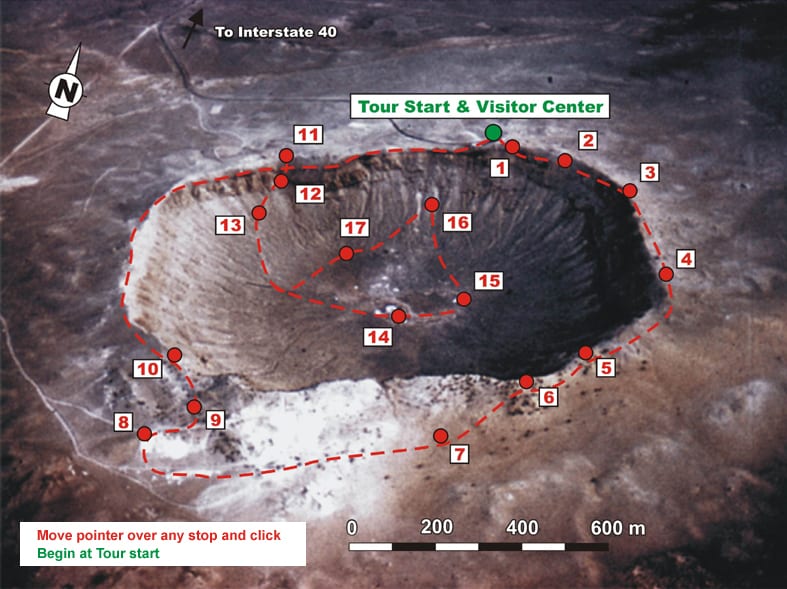
Explorer’s Guide to Impact Craters
Barringer Crater Tour
- Getting to Barringer Crater
- Virtual Tour of Barringer Crater
- Barringer Tour: Visitor Center
- Barringer – Stop 1
- Barringer – Stop 2
- Barringer – Stop 3
- Barringer – Stop 4
- Barringer – Stop 5
- Barringer – Stop 6
- Barringer – Stop 7
- Barringer – Stop 8
- Barringer – Stop 9
- Barringer – Stop 10
- Barringer – Stop 11
- Barringer – Stop 12
- Barringer – Stop 13
- Barringer – Stop 14
- Barringer – Stop 15
- Barringer – Stop 16
- Barringer – Stop 17
Stop 14 at Barringer
We’re now standing at the very center of Barringer Crater. Somewhere above us is ground zero where the 300,000 ton, 40 meter diameter nickel-iron meteorite struck around 50,000 years ago. The fresh crater would have been even deeper than it is today beacuse we’re standing on 30 meters of sediments that were deposited in a lake when this part of Arizona was much wetter than today.

Panoramic photo looking back toward the Caretaker Trail
Photo: G. Osinski, University of Western Ontario Location: Center of the crater floor
Scale: Height from the floor to the crater rim is approximately 180 meters

Tear fault at the southeast corner of Barringer Crater
Photo: G. Osinski, University of Western Ontario Location: Center of the crater floor
Scale: Height from the floor to the crater rim is approximately 180 meters
In the above photo, notice how a prominent layer of the Kaibab Formation (dashed white line) is offset along a fault.

Equipment from drilling operation on the crater floor
Photo: G. Osinski, University of Western Ontario Location: Center of the crater floor
Scale: Height from the floor to the crater rim is approximately 180 meters
In the photo above are the remains of a steam boiler and winch that were used to operate the hoist in the main drill shaft. The shaft, located very close to the center of the crater, was expected to encounter the large iron meteorite that Daniel Barringer thought was buried beneath. However, none was encountered and he later concluded that most of the meteorite impactor had either melted, vaporized, or been ejected out of the crater. To learn more about Daniel Barringer’s early exploration of Barringer Crater, see The Barringer Meteorite Crater website

